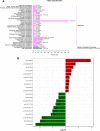Metabolome of flue-cured tobacco is significantly affected by the presence of leaf stem
- PMID: 36782114
- PMCID: PMC9926566
- DOI: 10.1186/s12870-023-04093-2
Metabolome of flue-cured tobacco is significantly affected by the presence of leaf stem
Abstract
Background: Leaves of tobacco (Nicotiana tabacum L.) are flue-cured to use as a key industrial supply in various parts of the world. The quality of tobacco leaves is dependent on chemical components and their proportions. Generally, the stem attached to tobacco leaf is detached before curing. However, the leaf stem remains green for an extended period of time (as compared to leaf) during flue-curing. Hence, it is expected to affect the quality of tobacco's final product.
Results: To understand the impact of the green stem of leaf on the metabolome of flue-cured tobacco, we employed a broad targeted metabolomics approach. We selected two tobacco cultivars (Yun87 and K326) and cultivated them in five geographic locations in China. For flue-curing, leaves were harvested without a stem (L) or with an attached stem (SPL). After metabolome analysis, a total of 1027 metabolites were annotated in these samples. A variable number of metabolites were differentially accumulated between both types of leaves (depending on geographic location or cultivar) representing an influence of environment or genotype. Interestingly, only 68 metabolites were differentially accumulated between L and SPL samples irrespective of the cultivar or geographic location. These differentially accumulated metabolites belonged to major groups of primary and secondary metabolites. We have discussed the importance of identified metabolites in terms of carbon, nitrogen, and polyphenolic metabolism.
Conclusion: The present research is the first comprehensive description of several metabolites in tobacco leaves related to the contribution of leaf stem. The current study opens novel prospects for investigating the potential of such metabolites in improving the quality of flue-cured tobacco.
Keywords: Leaf; Metabolites; Postharvest treatment; Quality; Tobacco.
© 2023. The Author(s).
Conflict of interest statement
Authors declare absence of any type of conflict of interest.
Figures





Similar articles
-
Climatic factors determine the yield and quality of Honghe flue-cured tobacco.Sci Rep. 2020 Nov 16;10(1):19868. doi: 10.1038/s41598-020-76919-0. Sci Rep. 2020. PMID: 33199769 Free PMC article.
-
Widely targeted metabolomics analysis reveals the mechanism of quality improvement of flue-cured tobacco.Front Plant Sci. 2022 Nov 29;13:1074029. doi: 10.3389/fpls.2022.1074029. eCollection 2022. Front Plant Sci. 2022. PMID: 36523627 Free PMC article.
-
Dynamic changes in physiological and biochemical properties of flue-cured tobacco of different leaf ages during flue-curing and their effects on yield and quality.BMC Plant Biol. 2019 Dec 16;19(1):555. doi: 10.1186/s12870-019-2143-x. BMC Plant Biol. 2019. PMID: 31842767 Free PMC article.
-
Metabolomic and transcriptomic analyses reveal differences in fatty acids in tobacco leaves across cultivars and developmental stages.BMC Plant Biol. 2025 Mar 11;25(1):312. doi: 10.1186/s12870-025-06337-9. BMC Plant Biol. 2025. PMID: 40069610 Free PMC article.
-
Multiomics provides insights into dynamic changes of aromatic profile during flue-curing process in tobacco (Nicotiana tabacum L.) leaves.BMC Plant Biol. 2025 Feb 24;25(1):244. doi: 10.1186/s12870-025-06273-8. BMC Plant Biol. 2025. PMID: 39994521 Free PMC article.
Cited by
-
The Bayesian mixture expert recognition model for tobacco leaf curing stages based on feature fusion.Plant Methods. 2025 Jun 16;21(1):86. doi: 10.1186/s13007-025-01384-7. Plant Methods. 2025. PMID: 40524222 Free PMC article.
-
Integration of QTL mapping and GWAS reveals the complicated genetic architecture of chemical composition traits in tobacco leaves.Front Plant Sci. 2025 Jun 25;16:1616591. doi: 10.3389/fpls.2025.1616591. eCollection 2025. Front Plant Sci. 2025. PMID: 40636011 Free PMC article.
-
Analysis of the relationship between color and natural pigments of tobacco leaves during curing.Sci Rep. 2024 Jan 2;14(1):166. doi: 10.1038/s41598-023-50801-1. Sci Rep. 2024. PMID: 38167588 Free PMC article.
-
Multi-split nitrogen application via drip irrigation improved dry matter accumulation, nitrogen uptake and utilization efficiency in flue-cured tobacco.BMC Plant Biol. 2025 May 21;25(1):674. doi: 10.1186/s12870-025-06728-y. BMC Plant Biol. 2025. PMID: 40399790 Free PMC article.
References
-
- Zi W, Peng J, Zhang X, Zhang L, Liu J. Optimization of waste tobacco stem expansion by microwave radiation for biomass material using response surface methodology. J Taiwan Inst Chem Eng Elsevier. 2013;44:678–685. doi: 10.1016/j.jtice.2012.12.022. - DOI
-
- Nikolova V, Drachev D. Investigation influence on quality of different curing preparation of flue-cured tobacco. Biotechnol Biotechnol Equip Taylor & Francis. 2005;19:75–79. doi: 10.1080/13102818.2005.10817157. - DOI
-
- Long M, Hua Y, Wang X, Wang Y, He C, Huangfu D, et al. Effect of different combined moistening and redrying treatments on the physicochemical and sensory capabilities of smoking food tobacco material. Dry Technol. 2018;36:52–62. doi: 10.1080/07373937.2017.1299752. - DOI
-
- Zhu WK, Wang Y, Chen LY, Wang ZG, Li B, Wang B. Effect of two-stage dehydration on retention of characteristic flavor components of flue-cured tobacco in rotary dryer. Dry Technol Taylor & Francis. 2016;34:1621–1629. doi: 10.1080/07373937.2016.1138965. - DOI
MeSH terms
Grants and funding
- 110202102036/China National Tobacco Corporation's key scientific and technological project "Research on the development and application of high-oil content tobacco leaves of China Tobacco that supports the big brand of cigarettes"
- 2021JCYL3JS2B026/the scientific and technological project of Hubei China Tobacco Industry Co., Ltd.
LinkOut - more resources
Full Text Sources

